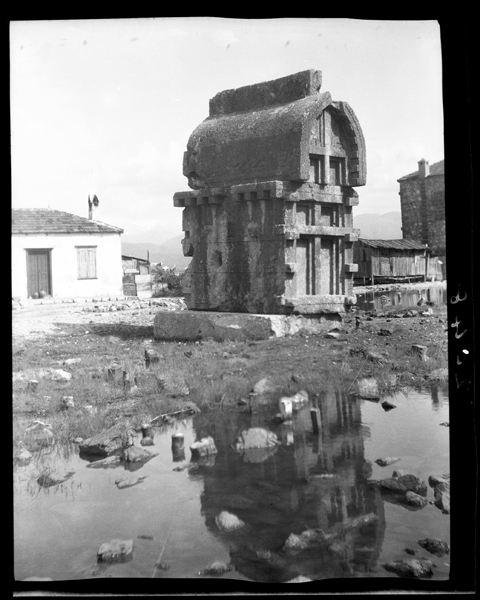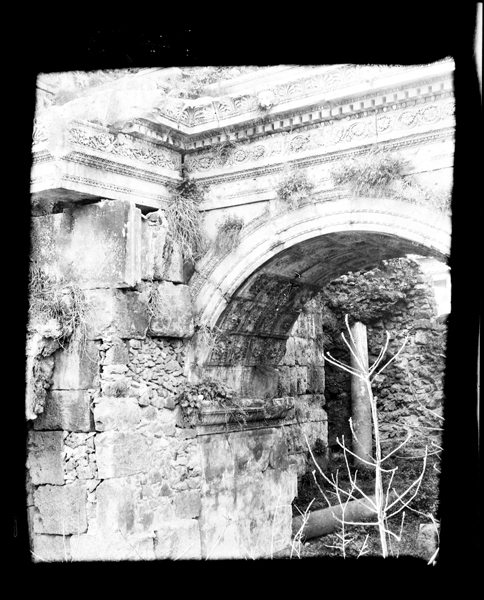Hasluck & Woodward in S.W. Anatolia: Images from the BSA SPHS Photographic Collection
Study tours – explorations to see and study landscapes, sites, monuments or to conduct ethnography in stiu – were (and still are) a part of life at the British School at Athens (BSA). Often these tours are conducted with a specific research question, but at times, it is simply a matter of expanding one’s knowledge into new territories which can, serendipitously, lead to further avenues of research.
In 1909, according to the Annual Report for the 1908-1909 academic session published in the Annual of the British School at Athens (ABSA), Frederick Hasluck, then Assistant Director of the BSA, and one of the BSA’s studentship holders, Arthur Woodward, travelled to ‘Rhodes, Telmessos, Attaleia [modern Antayla], Perge, Sillyon, and Aspendos’. The purpose of their visit is not stated. However, it is clear from Hasluck’s photographs and a few short published notes that he used part of his time to study Medieval monuments, a subject he was pursuing at the time. On the other hand, the Annual Report indicated that Woodward was studying inscriptions – in Attica and later at Sparta as part of the BSA’s ongoing archaeological excavations. Woodward’s reason for travelling to S.W. Anatolia (historic Lycia and Pamphylia) is less clear, but likely to be the case of taking advantage of the opportunity to expand his archaeological knowledge.
The BSA SPHS image collection contains 67 negatives from this 1909 study tour, donated separately by both Hasluck and Woodward. Images of Rhodes come only from Hasluck. Some of the photographs show the same monuments at these sites from slightly different angles, but it is clear that they were taken at the same time.
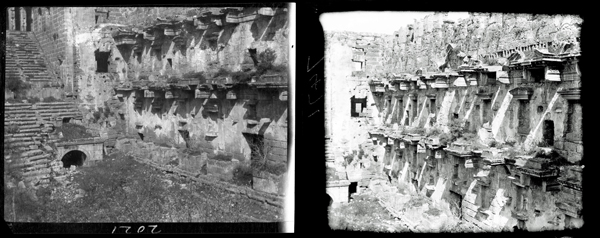
Aspendus (Pamphylia): Inside the Stage Buildings of the Theatre. Left: BSA SPHS 01/0560.2021 (Hasluck) and Right: BSA SPHS 01/3881.7471 (Woodward).
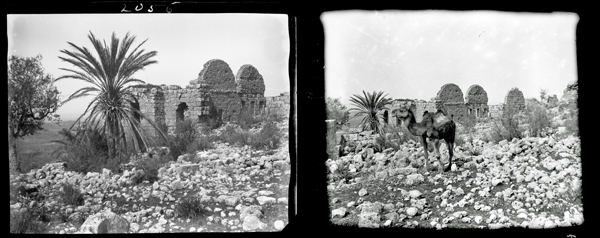
Sillyon (Pamphylia): ‘Antiker Palast’ (Large Building that could be either a Gymnasium or a Palace). Left: BSA SPHS 01/0598.2056 and Right: BSA SPHS 01/3889.7479 (Woodward)
Most of the sites visited (Aspendus, Sillyon and Perge) could be reached from the major harbour town of Antalya, ancient Attaleia and later known as Adalia, in the historic region of Pamphylia. Telmessos, in Lycia, is a natural stopping off point travelling from Rhodes.
Hasluck’s photograph of the town of Antalya would later be used in the 1936 exhibition at Burlington House in London celebrating the first 50 years of the work of the BSA. It was used as part of a poster highlighting Hasluck’s work on ‘Frankish and Moslem’ monuments. Woodward presented two images of Antalya to the SPHS, including one of Hadrian’s Gate, a prominent Roman monument in the town.
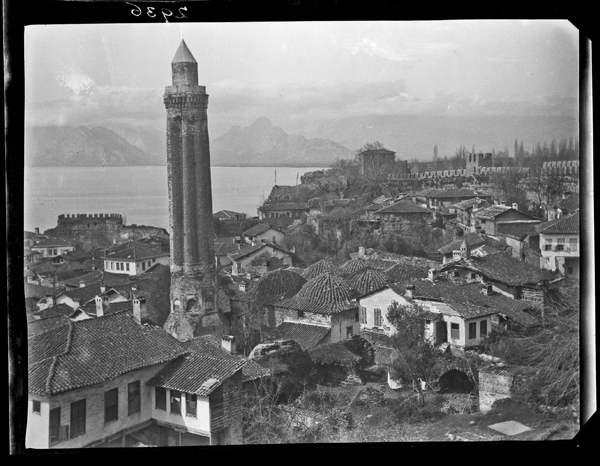
BSA SPHS 01/1118.2936. Antalya (Pamphylia): Fluted Minaret of Yivliminare or Alaaddin mosque (Hasluck)
It is notable that a major publication did not appear describing Hasluck’s and Woodward’s 1909 tour. There are two short notes by Hasluck, in line with his particular interests, on Frankish remains and a Frankish inscription in Adalia (Antalya) observed during this trip, but Woodward is silent. However, Woodward is mentioned by Hasluck for his challenging work in close proximity to a hot baker’s oven copying that Frankish inscription. The main evidence for this study tour is the brief statement in the Annual Report for the 1908-1909 academic session and the images in the SPHS collection. Taken on their own, photographs present only part of a picture. They can be put into context by aligning them with written data – archive information or published accounts. It is still a matter of ‘reading between the lines’ to tell a story since the information will always be incomplete. In this case, we can tell a story told about Hasluck’s and Woodward’s travels to S.W. Anatolia in 1909, but their motivation will remain a mystery.
As a postscript, it should be noted that Woodward and Hasluck purchased two prehistoric figurines in Antalya. These figurines would prove to be a serendipitous factor for Woodward, leading him to return to the area the following year, this time bringing with him BSA student, Henry Ormerod – a subject for another story.
Deborah Harlan
British School at Athens
Images from the BSA-SPHS collection are available on the BSA’s Digital Collections page.
For a continuation of this story, see Psidian Figurines and the Search for Prehistory in S.W. Anatalia
Click here for more BSA Archive Stories.
Further Reading:
Hasluck, F. W. 1908-1909. ‘Frankish Remains at Adalia’, Annual of the British School at Athens 15:270–273.
Hasluck, F. W. 1909. ‘A French Inscription at Adalia’, Annual of the British School at Athens, 16: 185–186.
